Domain authority checker
Check any number of domains for the main parameters: DR, number of dofollow and nofollow domains, gov links, edu links and more!
The first 7 days are free.
No credit card needed!
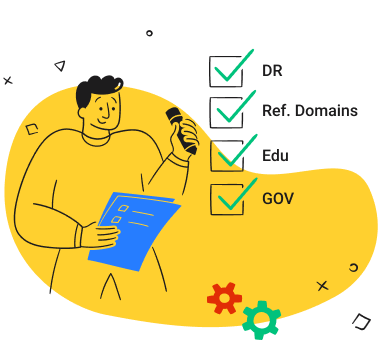
Key features of the Domain Authority Checker
In SEO, the success hinges on top-notch backlinks, and with Rush Analytics bulk domain authority checker, you can swiftly evaluate the quality of those providing the backlinks in just a few minutes.
-
Unlimited number of domains
Upload any number of domains, not 100, 200 or 1,000 at a time
-
Only the latest data
We show only the latest up-to-date data on links
-
Speed
We can check up to 500 domains in a minute – no need to wait hours for checks
Find quality domains that work best for you
For more detailed instructions on how to use the Domain Authority Checker Tool, we provide comprehensive instructions in our training video.
How it works
The tool was designed to assist you in selecting the most suitable domains for your private blog network.

-
Upload a list of domains
Submit a list of domains to review their link properties and check domain authority
-
Get Results
Get a detailed table of the most important domain parameters
What is Domain Authority Checker?
More nuanced and systematic method for tracking domain authority trends is here! Unlike standard tools, this tool doesn’t just assess the domain authority score but also offers intricate insights into the domain’s standing within the competitive landscape. It allows users to not only gauge how they rank but to understand the underlying factors influencing those rankings.
For seasoned SEO professionals, this tool offers an opportunity to delve deeper into the mechanics of domain authority, equipping them with the insights needed to make informed decisions and implement strategies that can yield better search engine results. It’s more than a statistical analysis; it’s a strategic tool that can be used to plan and execute SEO campaigns more effectively.
-
Results you get after checking:
- Backlinks – The count of backlinks to your domain
- Text – Whether text exists on the referring donor pages
- Image – Whether images are present on referring pages
- Nofollow – The count of backlinks that carry the “nofollow” attribute
- Dofollow – The count of backlinks that carry the “dofollow” attribute, which are active links directing the search bot to visit and index the page
- Redirect – The count of domains that redirect to your site
- Gov – The count of domains in the .gov TLD
- Edu – The count of domains in the .edu TLD
- Refdomains – The count of domains that refer to your site
- Refips – The IP addresses of donors
- Domain rating – The rating reflecting the backlink quality of your domain
You can download all this data in a convenient Excel format.
How does Domain Authority Tool help?
As domain authority becomes increasingly important to achieving success in search engine rankings, it’s beneficial to use a Domain Authority Checker Tool when creating or updating website content.
Benefits of Checking Domain Authority
- Identifying Strengths and Weaknesses: By regularly evaluating your website’s Domain Authority, you gain valuable insights into its overall authority in the eyes of search engines. This goes beyond a mere score; it’s a diagnostic tool that helps you understand where your site excels and where improvements are needed. For example, a high DA may indicate strong backlinks and quality content, while a lower score may indicate the need for increased SEO, better content or improved backlink strategies. Armed with this knowledge, you can develop a targeted action plan to address weaknesses and optimise your site’s authority, improving your search engine rankings and visibility.
- Competitive Analysis:Comparing your site’s domain authority with that of your competitors is a fundamental aspect of digital marketing strategy. It’s not about competing blindly; it’s about knowing where you stand in the competitive landscape. By conducting competitive analysis, you can identify areas where your competitors excel and where you have the potential to gain an edge. This knowledge enables you to adapt your strategies and content to outperform your competitors, whether through content quality, backlink acquisition or technical SEO improvements. By leveraging this competitive intelligence, you can position your website more effectively within your niche, attracting more organic traffic and gaining a competitive advantage.
- Strategy planning: Domain Authority insights are a linchpin of informed decision-making in your SEO strategies. Instead of relying on guesswork, you can base your planning on hard data. A deeper understanding of your site’s authority status allows you to tailor your SEO efforts to areas that need improvement, such as on-page optimization, content quality, or backlink building. This precision means that your resources are directed where they will have the greatest impact, resulting in a more efficient and effective SEO strategy.
How do you utilize the Domain Authority Checker Tool?
To engage with our DA checker tool, just initiate a task within the Rush Analytics platform, supplying information like target domains. Once you input this information, the verification begins, and in a brief time, you should obtain a detailed report encompassing metrics related to website backlinks and domain details.
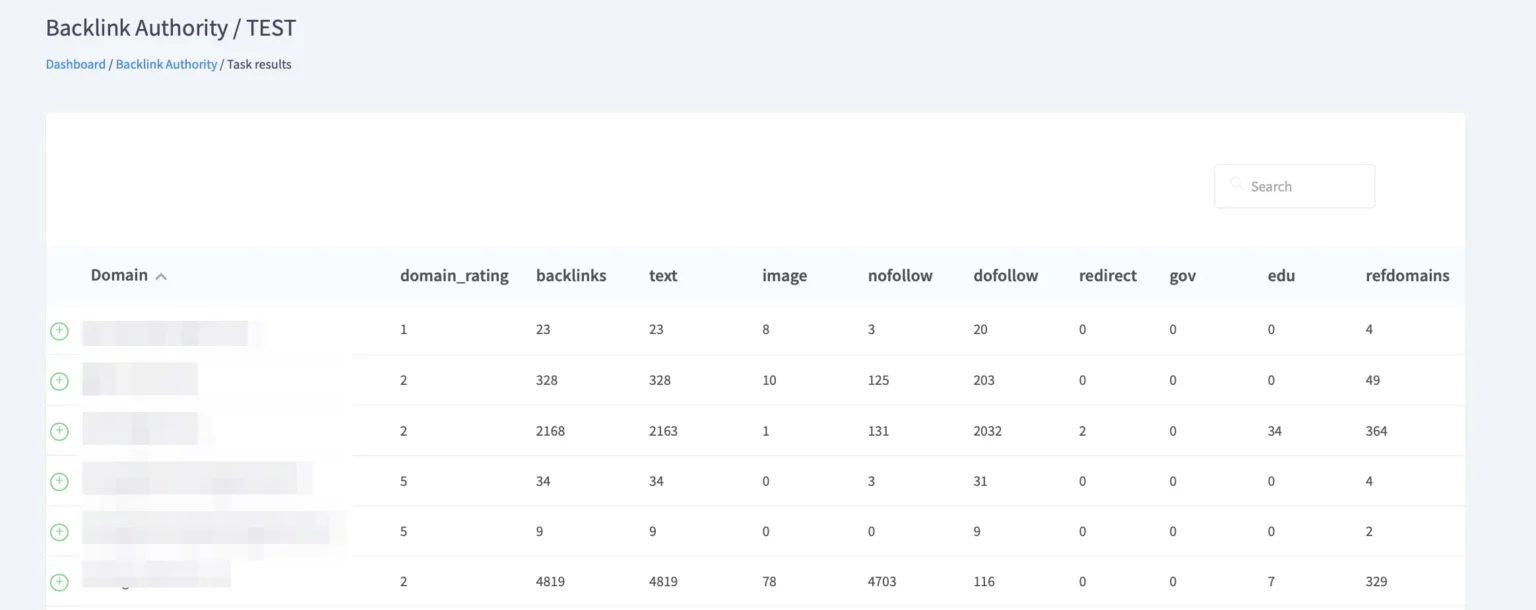
Parameters the Tool checks
1. Backlinks count
The count and quality of backlinks offer insights into a domain’s popularity and relevance. Analyse this information to gain insight into the effectiveness of different SEO techniques.
2. Text count
By assessing whether text exists on referring donor pages, SEO professionals can gauge the context and relevance of the links. This means that the backlinks are not only numerically strong, but also semantically aligned with the content, increasing the authority of the site.
3. Images
Images on referring pages, especially when tagged and described accurately, add to the user experience and SEO value. This reflects a complete content strategy that values both textual and visual elements, contributing to a more reliable assessment of domain quality.
4. Nofollow Links
Though nofollow links don’t directly contribute to SEO rankings, they provide insights into a site’s overall link profile. A natural mix of nofollow and dofollow links indicates a balanced and organic linking strategy, which is essential for maintaining domain quality.
5. Dofollow Links
These links contribute directly to the domain’s SEO rankings. Monitoring and ensuring the quality of these active links is essential for increasing domain authority and search engine visibility, and plays a vital role in assessing domain quality.
6. Redirects
The count and type of redirects to a site reveal the efficiency and user-friendliness of the site’s navigation. Properly implemented redirects preserve link equity, contribute to a positive user experience, and thus reflect a well-maintained domain.
7. Links from governmental sites
Links from governmental domains (.gov) are often considered highly authoritative. Having such links indicates a high level of trust and credibility, adding significant value to the assessment of the domain’s quality.
8. Links from educational sites
Similarly, links from educational domains (.edu) are seen as trustworthy and non-commercial. These links can raise the reputation of the domain and demonstrate its informational value, further supporting the quality assessment.
9. Referring domains
Analyzing the diversity and relevance of referring domains offers a multifaceted view of the site’s backlink profile. A varied and relevant collection of referring domains is a strong indicator of a domain’s authenticity and quality.
10. Refips
Evaluating donor IP addresses guarantees that backlinks are geographically diverse and legitimate. This helps in identifying unnatural link-building patterns, ensuring that the domain’s backlink profile remains authentic and of high quality.
11. Domain Rating
This cumulative metric reflects the overall backlink quality of the domain. Monitoring changes in domain rating provides a quick yet complete understanding of where the domain stands in terms of quality and how different backlink strategies are performing.
What is high domain authority score?
Domain authority is a composite metric that serves as a helpful gauge for understanding the strength and reputation of a website in the digital landscape. It’s formulated from multiple factors including linking root domains, the number of total links, and other proprietary measurements, and it’s presented as a score ranging from 1 to 100. A high domain authority score reflects a greater ability to rank in search engine results, making it a go-to reference for SEO professionals who aim to strategically position websites in competitive search environments.
The importance of domain authority transcends mere numbers. It acts as a barometer for SEO success, offering insights into how a website is perceived by search engines. In a world where search engine algorithms are ever-evolving and increasingly complex, domain authority provides a consistent frame of reference. It allows SEO experts to benchmark against competitors, identify areas for improvement, and formulate strategies that align with the goal of enhancing online visibility.
What to do with the results?
Once you have assessed the domain authority of your site or a competitor’s site, what can you do with this data? Here are several ways to make the most of this information:
- Benchmarking Position: Utilize domain authority data to benchmark your website’s position relative to competitors in your industry. By understanding where you stand in comparison to similar websites, you can identify gaps in authority and chart a path for improvement. This analysis not only helps you set realistic goals but also informs your strategies for outperforming competitors in search engine rankings.
- Marketing Effectiveness: Domain authority data is a useful indicator of the effectiveness of your marketing efforts. It allows you to assess whether your investment in marketing initiatives, such as content creation, link building, and social media campaigns, is paying off. By monitoring changes in your domain authority score over time, you can make data-driven decisions to optimize your marketing strategies for better online visibility and authority.
- Competitor Analysis: Delving into your competitors’ domain authority scores provides essential insights into your niche’s competitive landscape. Identify industry leaders and ascertain where your brand stands in comparison. This knowledge helps you formulate competitive strategies, enabling you to position your brand more effectively. By understanding your competitors’ strengths and weaknesses, you can target opportunities to gain a competitive edge
- Improved SEO: Domain authority data plays a pivotal role in enhancing your SEO efforts. Analyzing your website’s domain authority score helps you pinpoint areas requiring optimization. Focus on improving on-page SEO, content quality, and backlink acquisition strategies to boost your authority in the eyes of search engines. With a well-informed SEO approach, you can tailor your tactics to the specific needs of your website and eventually improve its search engine rankings.
- Quality Backlink Identification: Identify high domain authority websites within your niche to discover prime opportunities for quality backlinks. Armed with this information, you can strategize effective link-building approaches, such as guest blogging or collaborative content projects, to acquire authoritative and relevant backlinks. Building relationships with these authoritative sources can add credibility to your website and increase its visibility in search engine results, helping to improve organic traffic and search rankings.
What impacts domain authority?
Moz Domain Authority (DA) is a metric developed by Moz that provides an estimate of a website’s overall search engine ranking potential. It is a score on a scale of 1 to 100, with higher scores indicating a greater ability to rank well in search engine results pages (SERPs). There are several factors that influence a website’s domain authority, and understanding them is essential for website owners and digital marketers looking to improve their online presence. Here are some key factors that influence Domain Authority:
- Link Profile
The most significant factor affecting DA is a website’s link profile. This includes both the quantity and quality of backlinks pointing to the site. Backlinks from authoritative and reputable websites can significantly boost a site’s DA. For example, if a well-known industry publication links to your website in a relevant article, it can have a positive impact on your DA. Keep this in mind when creating your link building strategy.
- Content Quality
High-quality, original, and engaging content is essential for a high DA. If your website consistently publishes quality content that attracts readers and attracts natural backlinks, it will contribute to a higher DA. For instance, a blog that consistently produces informative and well-researched articles may see an increase in DA over time.
- Site Structure and User Experience
A well-structured and user-friendly website improves the user experience, which indirectly affects DA. If your site is easy to navigate, loads quickly, and provides a seamless experience for visitors, it’s more likely to attract and retain users. For example, an e-commerce site with clear product categories and a smooth checkout process can have a positive impact on DA.
- Social Signals
While the direct impact of social signals (likes, shares, and comments on social media) on DA is debatable, they can indirectly influence it by driving traffic to your site and increasing its visibility. For example, a viral social media post that links back to your website can lead to increased traffic and potentially higher DA.
- On-Page SEO
Proper on-page optimization, including optimizing meta tags, headers, and image alt text, can positively impact your DA. For instance, if you have a local business website and you optimize your pages with relevant keywords and location-specific information, it can help improve your website’s visibility in local search results and contribute to a higher DA.
- Technical SEO
Technical factors such as website speed, mobile-friendliness, and secure (HTTPS) connections play a role in DA. Search engines prioritize websites that offer a smooth technical experience to users. For example, a website that is optimized for mobile devices and loads quickly on all devices is likely to have a better DA.
- Domain Age and History
Older domains tend to have higher DAs because they have had more time to accumulate quality backlinks and establish authority. However, this doesn’t mean newer domains cannot achieve a high DA. It may just take more time and effort.
- Spam Score
Websites that engage in spammy practices, such as link farming or keyword stuffing, are likely to have a lower DA. Maintaining a clean and ethical online presence is key to being a good DA.
- Content Freshness
Keeping your content up-to-date and regularly adding new, relevant information can positively influence your DA. For example, a news website that frequently publishes breaking stories may see improvements in DA due to its fresh content.
How to increase domain authority?
Increasing domain authority is a multifaceted process that requires both careful planning and execution. Here’s what you can do:
Building High-Quality Backlinks to Increase Domain Authority
Focus on acquiring backlinks from reputable websites, as these serve as votes of confidence in your site’s credibility. Avoid shortcuts like paid links or link farms, as these may lead to penalties. Instead, consider guest posting, collaborative content, and genuine engagement with industry leaders.
- Guest Posting: By writing for an industry-leading blog, you can include a backlink to raise your domain authority. For instance, a health and wellness website might contribute to a nutrition blog about dietary trends, positively impacting the authority score.
- Collaborative Content: Collaborate with influencers or experts in your field to raise your domain authority score. A tech company co-creating a guide with a cybersecurity expert allows leveraging audiences, contributing to both page authority and domain authority.
- Genuine Engagement: Engaging in community discussions and including links to your site builds relationships and website authority. A travel blogger contributing to travel forums can be a great way to gain domain authority.
On-Page SEO Optimization
Make sure each page is optimised for relevant keywords, meta tags and user experience. Creating rich, original content that answers user questions is a cornerstone of this effort. Consistent internal linking also promotes better site navigation.
- Keyword Optimization: Including relevant keywords naturally helps in increasing both page authority and domain authority. A pet supply site using “organic dog food” or “sustainable cat toys” is on the right path.
- Meta Tags: Include accurate meta titles and descriptions for each page. For a page about “Vegan Cake Recipes,” a fitting meta description might be “Explore delicious and easy vegan cake recipes for every occasion.”
- User Experience: Designing for engagement not only improves the user experience, but also increases the overall authority of the site. An online bookstore’s interactive previews can boost both page and domain authority score.
Technical SEO
This includes making sure the website is mobile-friendly, loading speed is optimal, and the XML sitemap is well-structured. It’s all about creating a seamless user experience.
- Mobile-Friendly Design: Ensuring a responsive design can significantly impact your website’s authority. A fashion retailer’s adaptable design promotes both page authority and domain authority.
- Loading Speed: Optimizing load times preserves visitor interest and improves domain authority score. An online news portal must focus on loading speed to sustain reader interest and boost authority score.
- XML Sitemap Structure: A clear XML sitemap guides search engines, promoting efficient crawling and indexing, thus elevating the domain authority score. A complex site like a university’s benefits significantly from this structure.
Start using Rush Analytics today
Get 7 days free trial access to all tools.
No credit card needed!

What experts say about us
Flexible pricing
to suit your needs
- 0,01106 USD for 1 domain
Depending on the subscription plan *
Get 7 days free trial access to all tools.
Pick the right keywords from Google, YouTube and Yandex suggestions
Try for freeRelated Features
Creating a new task
1. Create a new task. The procedure is simple: first, select Backlinks Authority from the left side menu and click on it. You will be taken to the tool section. Then simply click on the “Create new task” button:
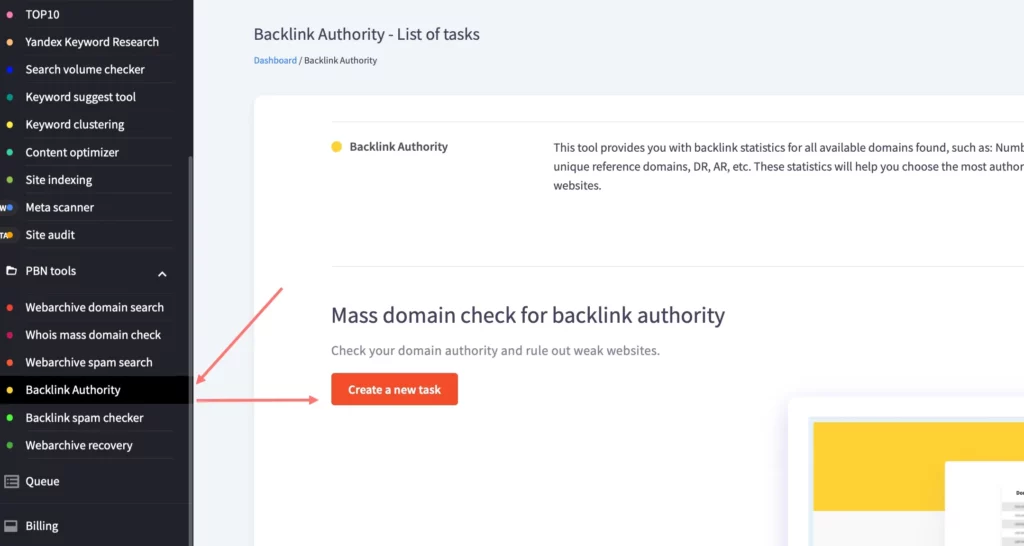
In the task creation window, enter its name and go to the next step.
Then, in the text area, add the domains you want to check, each on a new line, without http:// and www. You can also import them from an Excel file. Don’t forget to click on the “Add domains” button:
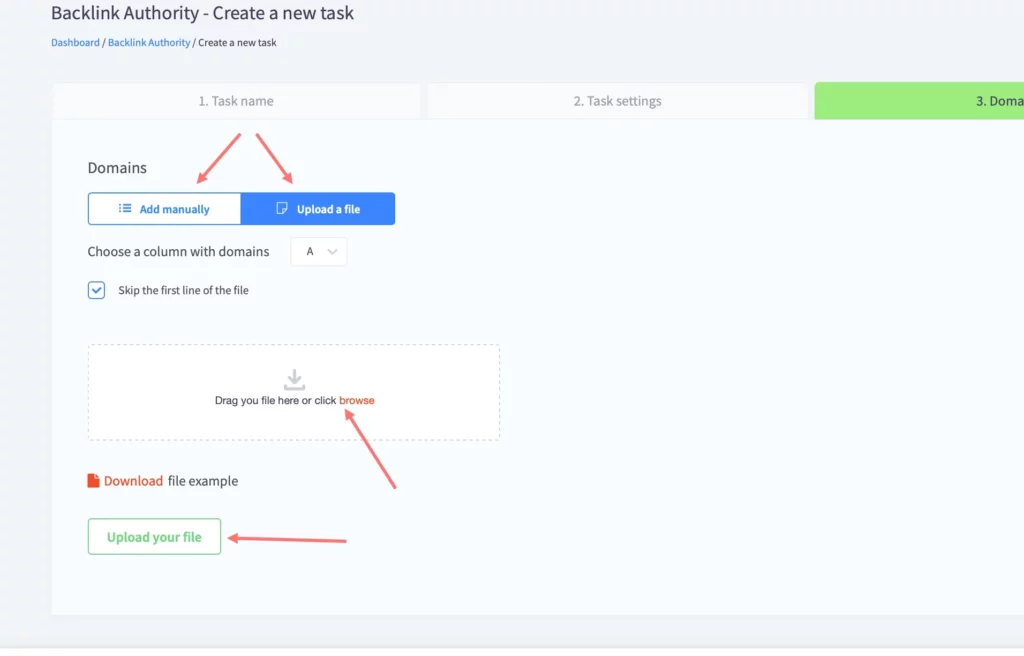
To start the task, click the “Create new task” button and then, in the window that appears, click to confirm.
The task you started will be displayed on the Backlink Authority task list. There, you can track the status of the task.
When the task is ready, a link to download a report file will appear, and you can also go to the task and view the results in the web interface:
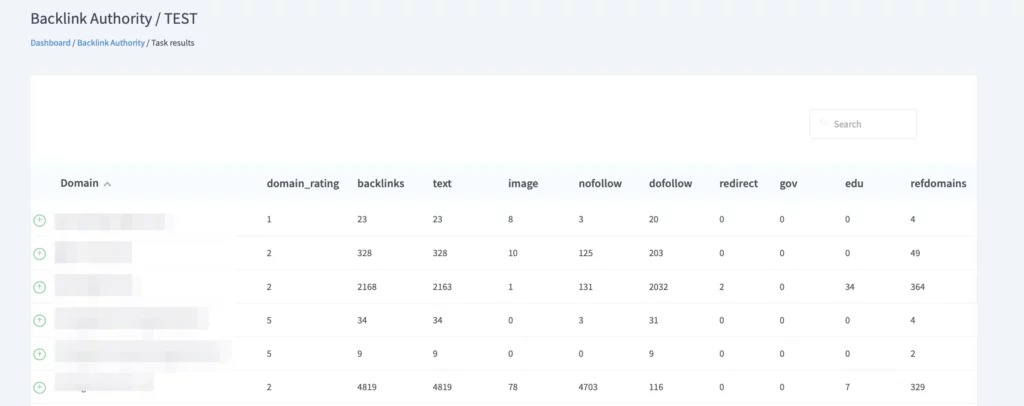
In the results of the task you will get domain backlink parameters:
- Backlinks – Number of backlinks to your domain
- Text – The presence of text on referring donor pages
- Image – The presence of images on referring pages
- Nofollow – Number of backlinks with the attribute “nofollow”
- Dofollow – Number of backlinks with the attribute “dofollow”: active links indicating for the search bot to go to the page and index it
- Redirect – Number of domains with redirects to your site
- Gov – Number of domains in the .gov TLD
- Edu – Number of domains in the .edu TLD
- Refdomains – Number of domains with referrals to your site
- Refips – Donor IP addresses
- Domain rating – The backlink rating of your domain
All this data can be downloaded in convenient Excel format.
Domain authority checker FAQ
Learn more about this tool by exploring our
Frequently Asked Questions Guide ➜




